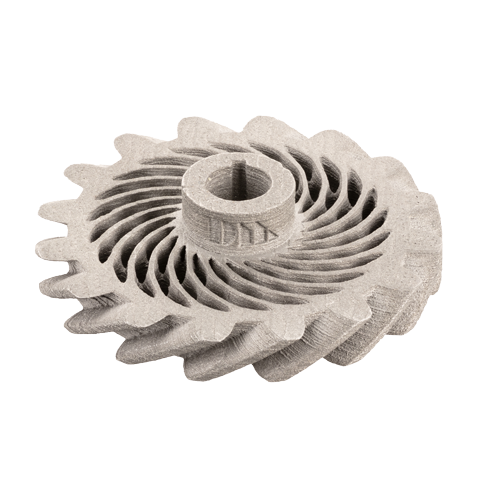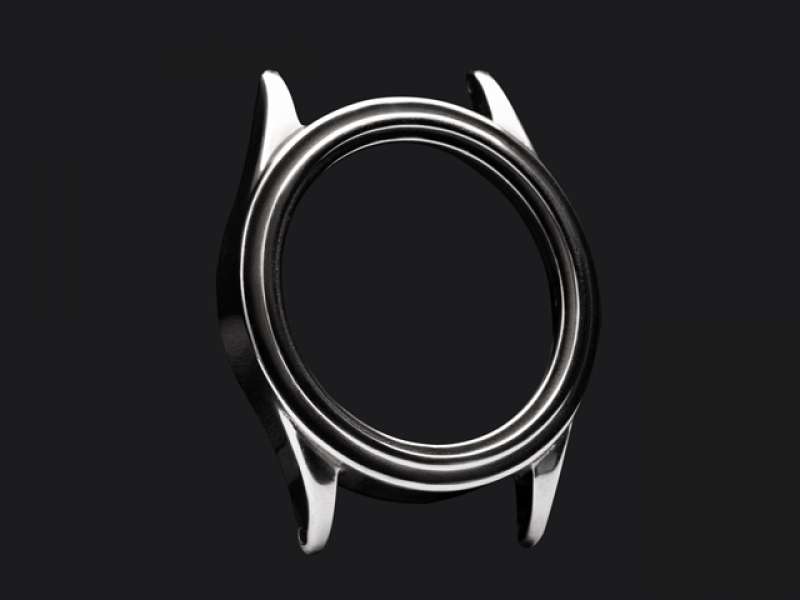Massachusetts-based Desktop Metal, who recently went public in a SPAC merger, announced today that their P-1 metal additive manufacturing machine has already begun shipping. Ric Fullop, CEO of Desktop Metal, has indicated that much of the company’s plans for expanding business hinges on the success of the company’s flagship P-50.
Both the P-1 and the P-50 are part of Desktop Metal’s new Production System line, which relies on a proprietary version of binder jetting technology called Single Pass Jetting (SPJ). As we reported, the P-50 will be released to the market in the latter half of 2021, and the P-1 release is meant to showcase the new SPJ technology on a smaller scale. The P-1 in effect, is meant to tide over the industry until the P-50 hits the market.

A 3D printed gear designed using nTopology‘s software and Desktop Metal’s Single Pass Jetting technology. Image courtesy of Desktop Metal.
Ford Motor Company purchased a P-1 and will receive it later this month, buying into the Desktop Metal’s promise to move metal additive manufacturing out of prototyping and low-volume custom part production. Featuring a 1200 dpi print bar and a printhead system that supports a large variety of materials, as well as an inert processing environment, the P-1 may have been attractive to Ford as it would allow them to experiment with printing both non-reactive and reactive materials. By experimenting with material science on the P-1, Ford could develop new parts for mass production on the P-50 system when it hits the market in 2021.
The SPJ technology on the P-1 works extremely quickly, depositing, compacting and binding metal powders in less than three seconds, including cleaning the printhead. If the SPJ technology works this quickly, cleanly, and efficiently with a wide range of metals, Ford could also begin producing smaller, more customized parts with the P-1 relatively quickly.

A watch component 3D printed using Desktop Metal’s Single Pass Jetting technology. Image courtesy of Desktop Metal.
One thing that Ford brings to the party is decades of additive manufacturing experience. Their record of early adoption of AM systems stretches back to 1988, when they acquired the third-ever commercial stereolithography system, according to Ford’s Director of Vehicle Research and Technology, Cynthia Flanigan.
Flanigan elaborated on her company’s plans for the P-1, saying, “We expect that this new system will serve as an important tool in the development of our future advanced process and alloy implementation, enabling our researchers to investigate additional production opportunities of metal Binder Jetting at Ford Motor Company. Our early collaboration with Desktop Metal highlighted the need for a lab-scale system that is aligned with the functionality of the production scale system so we can further develop expertise around this process.”
The P-1 metal AM machine also comes with a manufacturing build preparation software, Desktop Metal’s Fabricate, and the company’s new Live Sinter application. Live Sinter uses powerful computing to simulate the sintering process. It then generates geometries for the build that account for the material distortion that occurs during sintering. This will help Ford and future P-1 customers efficiently navigate prototyping parts and validating materials while keeping metal powder waste costs to a minimum.
In effect, the P-1 is a valuable placeholder for the more robust P-50 system, enabling customers to practice and experiment with materials and part production in smaller volumes so they can rapidly scale batch printing of components to numbers approaching those of mass production performed by traditional manufacturing methods.
But there are those who voice their doubts about Desktop Metal’s claims, and to truly understand how their P-50 Production AM machines fit into industry trends writ large over the next ten years, be sure to check out the “Additive Manufacturing with Metal Powders 2020” and “The Market for Metal Additive Manufacturing Services: 2020-2029“ reports on the subject from SmarTech Analysis.
Subscribe to Our Email Newsletter
Stay up-to-date on all the latest news from the 3D printing industry and receive information and offers from third party vendors.
Print Services
Upload your 3D Models and get them printed quickly and efficiently.
You May Also Like
Heating Up: 3D Systems’ Scott Green Discusses 3D Printing’s Potential in the Data Center Industry
The relentless rise of NVIDIA, the steadily increasing pledges of major private and public investments in national infrastructure projects around the world, and the general cultural obsession with AI have...
Formlabs Teams Up with DMG MORI in Japan
In late June, Nick Graham, Chief Revenue Officer at Formlabs, announced on LinkedIn that the company had partnered with DMG MORI, one of the world’s leading machine tool companies, to...
EOS in India: AM’s Rising Star
EOS is doubling down on India. With a growing base of aerospace startups, new government policies, and a massive engineering workforce, India is quickly becoming one of the most important...
3D Printing News Briefs, June 25, 2025: R&D Materials, 3D Printed Veneers, & More
In today’s 3D Printing News Briefs, 3DXTECH has launched a program that gives customers early access to experimental materials, and the first Lithoz CeraFab Multi 2M30 in the Czech Republic...



































